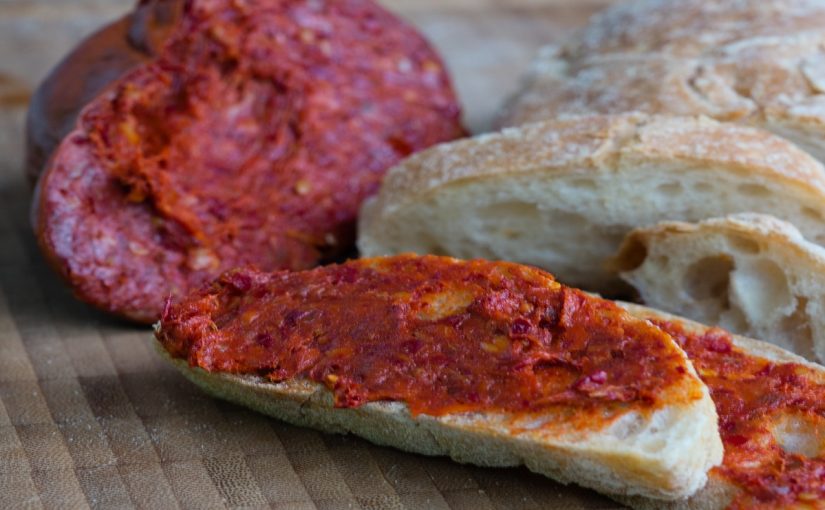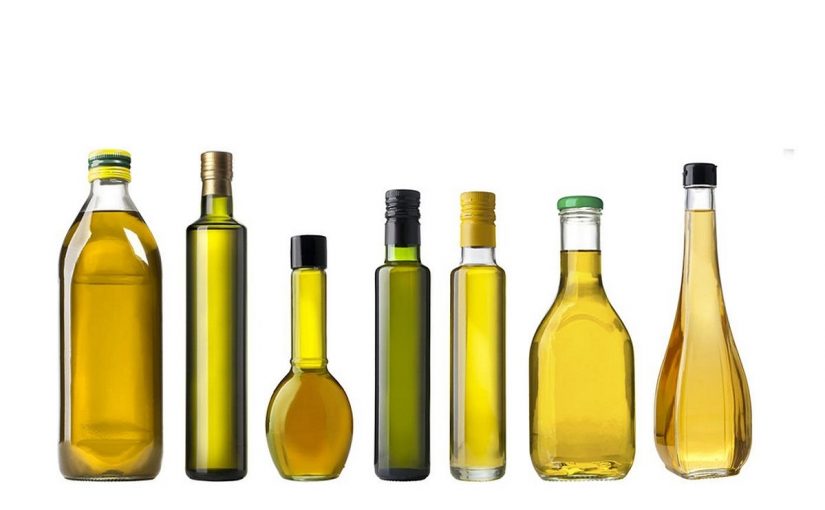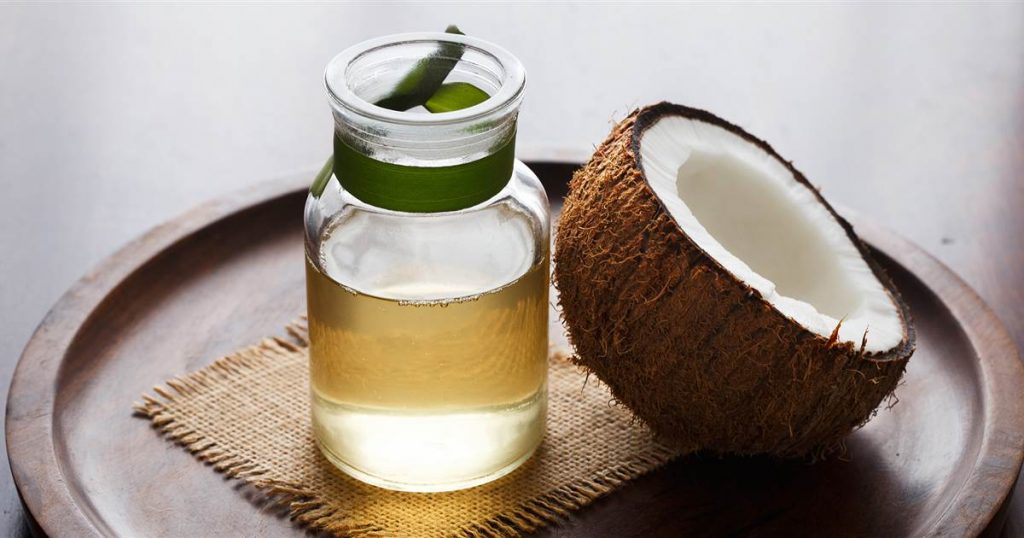7.9.2020
We do not always evaluate with deep attention, precisely and with concentration, what we eat. Surely, the world of food really fascinates everyone and capture our attention, but what do we really need to eat to live well? What is the correct way to feed? Now and in the Future?
There is a plenty of solutions, of diets, of cuisines, of gastronomies, one each population on earth. It is very strange try to propose a single method, a point of view or a philosophy about nutrition; it is quite impossible. We can at least recommend some basic treatments of medical source about a balanced diet, in terms of “ingredients”, namely something to add or not forgetting to add to the world kaleidoscope of cuisines.
We have always to start from the earth and its products, therefore giving greater space to fruit and vegetables. The usual five portions a day should be the panacea for living well, but there is more.
To stay healthy as long as possible, you need to limit the consumption of meat. We refer precisely to the red one and sausages. On the other hand, fish can be consumed, remember that it is an important source of protein.
As for carbohydrates, let’s forget the pasta Italians, commonly consume. We must go back to the origin, to the source of the Mediterranean diet, by consuming whole grains. Pasta is fine, but integrate them. The refining processes have removed the essential from this precious product, the same goes for rice. There is also plenty of space for millet, oats, spelled, etc. etc.
Let’s not forget the legumes. A healthy food that must continue to be present on our tables. From lentils to beans, from chickpeas to soy, the latter coming from other cultures but a food definitely worth keeping in mind.
It is also good to consume milk and dairy products, but do not overdo it.
The olive oil is excellent, rich in beneficial and protective properties.
We avoid the use of sugary drinks and excessively caloric foods.
Yes to wine, but in moderation.
This simple phenomenon of addition of “ingredients” has a particular name, you have to add to your local cuisine the peasant diet, which is called “Mediterranean diet”. And you can find that, to the nth degree, in Calabrian cuisine!!
In Calabria, every day, you can put on the table: fruit, vegetables, unrefined cereals, legumes, nuts, olive oil, milk and derivatives. Of course, it would be advisable to practice physical activity daily and to consume during the week fish, eggs and white meats. Red meat only monthly.
SOME SPECIAL RECIPES OF CALABRIAN CUISINE
In order to illustrate the variety, but also the richness and pleasantness of Mediterranean cuisine in Calabria, we suggest some recipes, maybe the more caloric, like sweets, which are rather easy to make, but which demonstrate the healthy nature of such Mediterranean diet. Hereinafter, you will find a brief overview of the most representative Calabrian foods.
APPETIZERS
VECCHIAREDDRE CU L’ALICI (pancakes with anchovies)
Actually, classic Calabrian cuisine does not like street food, what you eat quickly and in the midst of people, but prefers tranquility, a sedentary lifestyle around a table full of relatives and friends.
However, the new is advancing and with giant steps and so this fashion has exploded among the new generations, indeed this lifestyle. The stalls that sell the specialties of the territory can now be found everywhere: in the markets, at the fairs, in the squares, wherever there is an audience.
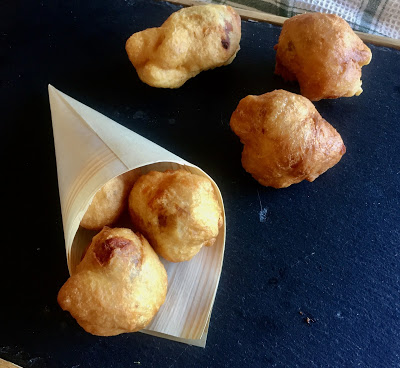
In Calabria you can taste different street food foods, poor foods, inherited from traditional cuisine: sandwiches stuffed with salami or fried vegetables, morzeddu, rustic pitte, vrascioli, zeppole. And it is precisely the latter (zeppole with anchovies, fried pancakes) that I want to talk to you about.
The name and shape of this very tasty street food, crunchy on the outside and with a warm and soft heart inside, changes according to the territory of origin: cullurielli, cuddruiaddri, vecchiareddre, crispelle, viveinelle, zippuli; they can be shaped like a donut, a ball or a stick. Made with or without potatoes, they are stuffed with nduja, anchovies in oil, dried tomatoes or cod.
In the sweet version they have a coating of granulated sugar. In ancient times the vecchiareddre were prepared only on Christmas Eve, today there is no event in which there is not a pot full of oil with an old (very old) lady (the “vecchiareddra”) intent on frying these delicious delicacies to eat simply with her hands, among the people.
Ingredients
- 500 grams of flour 00
- 250 ml of water
- 20 gr of fresh brewer’s yeast
- anchovies in oil
- salt
- sunflower oil
Preparation
Drain the anchovy fillets well, pat them with absorbent paper and set them aside.
Dissolve the yeast in the warm water, add the flour, salt and extra virgin olive oil. Work well, adding more water if necessary, to obtain a homogeneous and very soft mixture. Let rise until doubled, deflate the dough again and let it rise again. Then with your hands greased with oil remove small pieces of dough and with the thumb and forefinger of your right hand form a ball that you will fill with an anchovy fillet.
If you want you can also give the shape of a cylinder. Fry a few vecchiaredde at a time in plenty of hot oil with the help of a ladle, until they have a honeyed color. Drain them and arrange them on absorbent paper.
Taste the vecchiaredde as soon as they cool down a little.
CALABRIAN TORTANO (bread as a cake)
This bread, originally from the upper Cosenza area, represents rebirth and the eggs that decorate it bear witness to this. In ancient times it was prepared with lard and mother yeast and cooked in a wood oven, it is often proposed with some small variations that have not altered its flavor anyway.
Ingredients
- 500 grams of flour 00
- 12 gr of fresh brewer’s yeast
- 3 eggs
- 50 ml of extra virgin olive oil
- a teaspoon of salt
- a spoonful of fennel seeds
To decorate it:
- 3 hard-boiled eggs
- oil for brushing
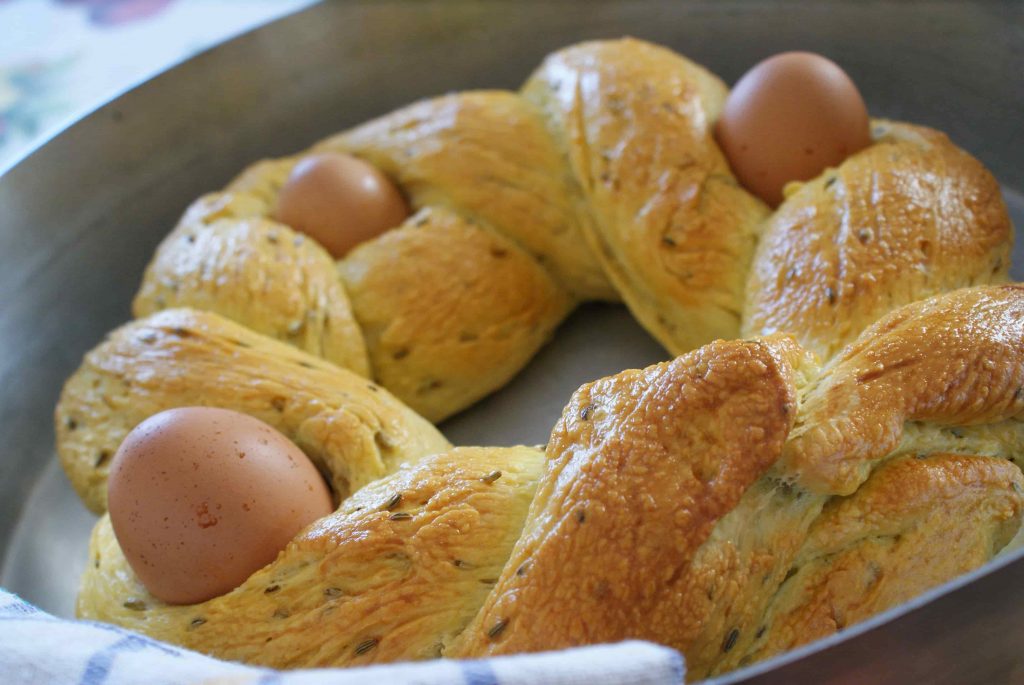
Preparation
Pour the flour with the fennel seeds into a bowl and mix well. Then add the yeast dissolved in half a glass of warm water, the eggs lightly beaten with salt and oil. Knead until you get a compact and elastic dough. Let rise until doubled (usually oven for about three hours). After this time with the leavened dough, form two equal cords, intertwine them and then form a donut. Arrange the eggs between the hollows and let them rise again in a baking pan lined with parchment paper.
Once the tortano has risen, brush it with oil and bake in a preheated oven at 180 ° for 30/35 minutes, until golden brown.
Remove from the oven and let it cool before enjoying it.
FRITTELLE CON ORTAGGI SOTTO SALE (pancakes with vegetables under salt)
In the Calabrian dialect they are the “pittedi cu u salaturi”, an appetizing fried dish that is the pride of our traditional cuisine.
‘U salaturi as well as being the characteristic glazed terracotta pot used for provisions, also indicates the set of vegetables that are preserved in salt. In my family we use to salt peppers, eggplants and onions, elsewhere they also add crushed olives and green beans. In truth, all those vegetables available are used, the important thing is that they are at 0 km. Once ripe, ‘u salaturi is excellent fried with sardines in oil (here) or to flavor chicken (here).
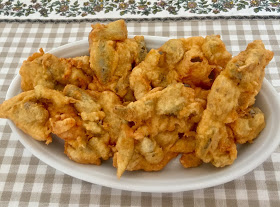
Like all grandma’s recipes, these pancakes are quick and easy to prepare, but … weightless. In fact, everything was made according to the saying “quantu Basta“, or “na junta“, that is a handful. I remember that at the beginning my mother used to fry one only to test its flavor and consistency. For safety, I prefer to weigh.
Now let’s go and prepare our frittelle.
Ingredients
- 200 grams of flour 00
- 50 gr of grated Calabrian pecorino
- 1 egg
- Salt to taste.
- hot pepper in seeds to taste
- 100 gr of salted
- cold water q.s.
- Seed oil for frying
- “u salaturi”
Preparation
First wash the vegetables to remove any residual salt, dab them with absorbent paper and then cut them into strips.
Put the flour in a bowl, pour the egg in the middle and gradually pour the water. When the mixture begins to be fluid, add the salt, chilli, pecorino and vegetables. Mix everything and if necessary add more water. Let it rest in the fridge for half an hour.
After this time, put a pan on the fire and as soon as the oil is hot, start frying the pancakes. Once golden on both sides, drain them and let them dry on absorbent paper.
An appetizing and tasty finger food to be enjoyed even cold … if you have enough left over.
MILANZANI SUTT’OGGHIU (eggplants in oil)
This recipe needs:
– Dark purple eggplants
– Sterilized jars.
As for the preparation you can follow the method with cooking or without. Both procedures involve a first passage in salt to dehydrate the vegetables, the difference lies in the second phase.
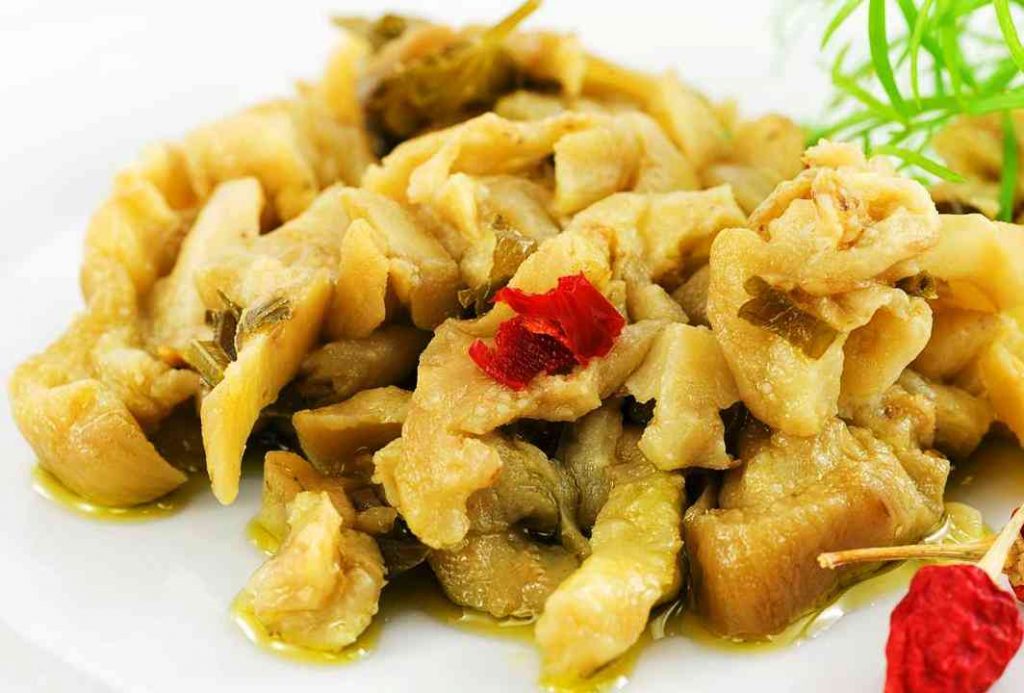
In the cooking method, the eggplants are blanched in a mixture of water and white vinegar; in the method without cooking they are put in vinegar for 24 hours, always under pressure.
If you want to consume the eggplants immediately, it is recommendable the first procedure, which is not valid for long storage as the eggplants become soggy.
The eggplants can be prepared both fillet and slices.
Ingredients
- eggplant
- White vinegar
- salt
- basil
- garlic
- hot pepper
- extra virgin olive oil
Preparation
Wash the eggplants well and after having deprived them of the stem, peel them. Cut them into slices, lengthwise and then fillet (matchstick). Transfer the eggplants to a colander, salt them abundantly and then put a weight on them and leave them for 24 hours. In this way, all the vegetation water, usually bitter, will be expelled.
After this time, squeeze the eggplants well and place them in a container covered with white vinegar. Cover them with a plate and a weight on top. Leave them like this for another 24 hours.
At this point, squeeze the eggplants well in a cloth, they must be dry (pressing them before).
Pour the eggplants into a large salad bowl and season with garlic cloves, basil leaves, sweet and spicy chillies. Stir and start filling the previously sterilized jars, taking care to press each layer well. This is to eliminate as much air as possible. At this point you just have to cover the eggplants with excellent olive oil. Do not close the jars immediately as the oil will tend to go down to fill the empty spaces and then you will need to add more. For a good conservation the eggplants must be covered with oil. Keep the jars in a cool place and do not open them for two months.
FIRST COURSES
SPAGHETTI ‘NDUJA AND RICOTTA
A typically Calabrian dish is spaghetti with ‘nduja and ricotta. It is a first course prepared with two products of our food and wine tradition: ricotta and ‘nduja.
Ricotta of sheep’s milk is a lean dairy product that has been produced and consumed by the shepherds of Calabria for centuries; ‘nduja is a soft and spicy cured meat that is produced in the territories of Vibo Valentia and has now become synonymous with Calabria.
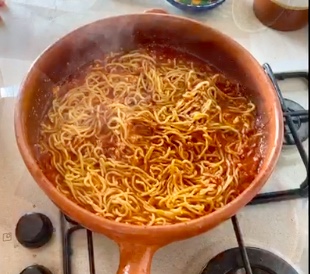
These two specialties used within the same recipe create a perfect balance: the spiciness of the salami is tempered and enhanced by the aroma and mellowness of the ricotta.
Ingredients
- 200 gr of spaghetti
- 150 gr of sheep’s milk ricotta
- 50 gr of ‘nduja *
- 250 ml of tomato sauce
- 1 clove of garlic
- extra virgin olive oil
- Salt to taste.
- ricotta salata
- the amount of ‘nduja is personal, depending on your ability to tolerate the spiciness
Preparation
You need the homemade spaghetti with 200 grams of 00 flour and 2 eggs
In a pot, earthenware, heat the garlic clove in extra virgin olive oil. As soon as it starts to brown, lower the heat and pour the ‘nduja. Mash it with a ladle to melt it and then pour in the tomato sauce and salt. As soon as the sauce is slightly reduced, add the ricotta, mix it well.
In the meantime, you will have cooked the spaghetti and once ready pour them into the sauce, stirring them for a few minutes in the hot sauce.
Now your ricotta and ‘nduja pasta is ready, plate it up and serve it with a grated ricotta salata (salty ricotta).
PASTA A LA TIELLA (pasta and potatoes)
This is an ancient dish of the Cosenza peasant tradition. A dish with poor ingredients, but rich in taste.
In ancient times it was a wood-fired oven dish, in fact the tiella, a pan made of aluminum or tinned copper with a lid, once prepared was entirely covered by hot coals to create the oven effect and not to evaporate the liquids necessary for the cooking ingredients. Today it can be done very well in the domestic oven, even if some prefer to carry out a first cooking on the stove and then complete it in the oven.
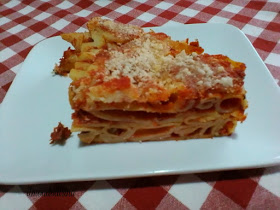
Tradition has it that the pasta shape is a “zito” (a long and big spaghetto) spezzato, in any case always smooth and not striped pasta and that the potatoes are absolutely from the Sila plateau.
The peculiarity and also the difficulty of this dish is the raw cooking, so you have to pay attention to the cooking times so as not to risk having overcooked pasta and raw potatoes.
Ingredients
- 300 gr of smooth feathers
- 500 ml of tomato sauce
- 4 medium potatoes
- bread crumbs
- Origan
- fresh pecorino
- grated pecorino
- garlic
- chili pepper
- extra virgin olive oil
- Salt to taste
Preparation
In a saucepan, brown the garlic clove and the chilli pepper with the oil. Add the sauce, add salt and cook for about 10 minutes. Do not thicken it, it must remain rather liquid. Thinly slice the potatoes. In a pan with high sides pour a couple of ladles of sauce, placed over the penne, then the potatoes, grated pecorino, flaked pecorino, oregano and more sauce.
Continue making another layer of pasta, potatoes, cheeses, oregano and sauce that must cover everything. Sprinkle with grated pecorino cheese mixed with breadcrumbs and sprinkle with a drizzle of extra virgin olive oil.
Cover the pan with parchment paper and then seal it with aluminum foil and bake at 200 ° for at least 20 minutes. Then remove the paper and brown the pasta and potatoes for at least 15 minutes. Let it rest before serving.
CALABRIAN SCILATELLE CHIJNI (filled pasta)
Sunday is not Sunday in Calabria if it is not prepared with chijna pasta.
Scilatelle in Calabria are also called maccaruni cu ferru, fileia, strangugliaprieviti, firrazzul, scialatelli, depending on the place of origin. In ancient times, the stem of the spike of the saracchio or disa, a shrub that grows in clayey soils, was used to roll the dough, subsequently knitting needles or umbrella underwire were used. Many use today a wooden skewer.
The term could derive from “scialari” which in the Calabrian dialect means to be happy. In short, the ancients certainly knew what today is scientifically explained: the consumption of pasta helps the production of serotonin, the good mood hormone.
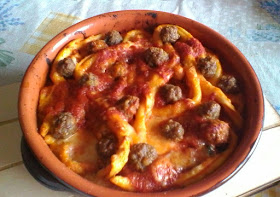
As tradition dictates, this type of pasta, made solely with durum wheat flour, water and salt, is seasoned with rich tomato-based sauces and goat, pork and veal meat, but also with fish.
It is wonderful to prepare it “chijna” (fill of cheese) in the oven, because fresh pasta absorbs the sauce more. A pleasure with all those meatballs, hard-boiled eggs, the very good soppressata and the scamorza cheese.
Ingredients
– For pasta
- 300 gr of durum wheat semolina
- lukewarm water q.s.
- a pinch of salt
- a drizzle of extra virgin olive oil
– For the sauce
- 700 ml of tomato sauce
- 1 clove of garlic
- extra virgin olive oil
- Salt to taste.
- 2 basil leaves
– For the meatballs
- 200 gr of minced veal
- a handful of breadcrumbs
- 1 egg
- 1 tablespoon of grated Parmesan cheese
- 1 tablespoon of grated pecorino
- Salt to taste.
- fry oil
- Scamorza,
- Calabrian soppressata,
- grated parmesan,
- hard-boiled eggs
Preparation
Prepare the scilatelle: put the flour, oil and salt on the pastry board and start kneading adding the water a little at a time. You need to get a firm and elastic dough. Let it rest covered for half an hour. Then form many sticks with the dough, wrap them around the stick without pressing too much and with the palm of your hand “scilate” going back and forth on the pastry board. Remove them gently and place them on a floured tray, aligning them.
For the meatballs: In a bowl pour the previously soaked and squeezed bread crumbs, the meat, the cheese mix, the egg and the salt. Knead with your hands until all the ingredients have mixed well. Let it rest and in the meantime prepare in sauce.
In a saucepan pour the oil and the garlic clove, as soon as it takes on color, add the sauce, salt and basil leaves. Cook over low heat for about thirty minutes and once ready, remove the clove of garlic from the sauce.
Now, with great patience, form the meatballs, the size of a hazelnut and fry them in plenty of hot oil.
Boil the scilatelle in abundant salted water in which you will pour a drizzle of oil, drain and pour into a large pan (the so called “tiana“) that can also go in the oven. Season them with a part of the sauce and gradually add the Parmesan cheese, a part of the meatballs and the hard-boiled eggs, the smoked cheese and the previously shredded soppressata. Mix everything together.
On the surface distribute the remaining meatballs, a few ladles of sauce and a sprinkling of Parmesan cheese. Bake at 200 ° for about 10 minutes.
Serve the scilatelle chijne alla Calabrese warm and …. “Buon Appetito!”
SECOND COURSES
PATATE ‘MPACCHIUSE (potatoes with red Tropea onion)
Mpacchiuse Potatoes are a typical side dish of popular Calabrian cuisine and in particular of the Cosenza area. They are crunchy on the outside and soft on the inside.
Why ‘mpacchiuse? Because during cooking they stick to each other, even if each one keeps its own crust. Unlike the classic French fries that are cooked in abundant oil and are turned continuously so that they do not stick together, the ‘mpacchiuse potatoes must cook in very little oil and are turned very little, so that they stick well together, because the more they are stuck , the more packaged they are and of course the better.
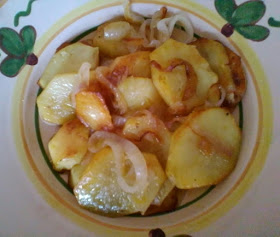
However … the fundamental ingredient of this tasty side dish is the Sila potato rich in good starches, vitamins, fiber, but above all rich in tryptophan, an amino acid responsible for the production of serotonin, the so-called happiness hormone that improves mood and makes you sleep more. In short, one more reason to consume ‘mpacchiuse potatoes!
There are many variations, with porcini mushrooms, with onions, cruschi peppers and eggs.
The today recipe is with onions, from Tropea of course, a dish rich in taste and intense aroma.
Ingredients
- 4 Silane potatoes
- 1 Tropea onion
- extra virgin olive oil
- Salt to taste.
- fresh or powdered chili
Preparation
Wash the potatoes, peel them and cut them into slices (1/2 cm).
Peel and cut the onion.
In a pan pour a drizzle of extra virgin olive oil and heat it up, add the potatoes, salt and chilli.
Mix and cover. Halfway through cooking add the onion, mix the ingredients together and continue cooking, stirring from time to time and always with the pan covered.
The ‘mpacchiuse potatoes are ready when they are stuck together and golden on all sides. Drain them with a slotted spoon and serve hot.
SWEETS
FRITTI A BBENTU (Fried sweets)
Who said that to make a good dessert you need eggs and creams? “Fritti a Bbentu” are proof that with water, flour, oil, bay leaf and sugar it is possible. Thanks to an ancient tradition, you can prepare a dessert thatyou will never stop eating.
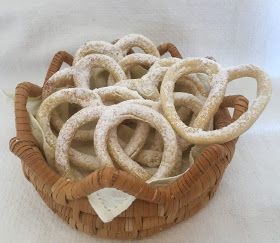
The fritti a bbentu or scoratedd are typical of the Sybaris region and require, according to tradition, some superstitious steps in the preparation otherwise the dessert does not take shape during frying. They generally have a good omen, meaning that they are in fact prepared for special occasions: the birth of a child, an engagement, graduation…
Ingredients
- 500 ml of water
- 350 grams of flour
- a pinch of salt
- 50 ml of extra virgin olive oil
- 2/3 bay leaves
- caster sugar
- powdered sugar
- cinnamon
- Seed oil for frying
Preparation
Put the water, bay leaves, salt in a saucepan and draw a cross on them with the oil. As soon as the water starts to boil, pour in the flour, half durum wheat and half soft wheat and mix quickly and vigorously until the dough comes off the walls.
Turn off the heat and place the dough on a pastry board greased with oil and knead it while still hot. Make many cords from the dough and give them their characteristic shape.
Heat plenty of seed oil and fry the fritti a bbentu. As soon as they are golden, drain and pass them in granulated sugar before eating them still hot. You can also sprinkle them with cinnamon or dip them in cooked must.
A skillful cook gives an additional sprinkle of powdered sugar mixed with cinnamon powder.
L’ABBACULU DI SAN BIAGIO (The cane of Saint Biagio)
This typical dessert from Serra San Bruno is a nzuda-type biscuit (nzuda is a typical oven cooked biscuit in Calabria) that is prepared on the occasion of the Saint Biagio festival. It is not easy to have the recipe both because it belongs to the oral tradition and because whoever holds it jealously preserves it. The version we describe is crunchy on the outside and with a soft heart on the inside.
However, why does the biscuit have the form “do baculu“, namely of the stick or cane?
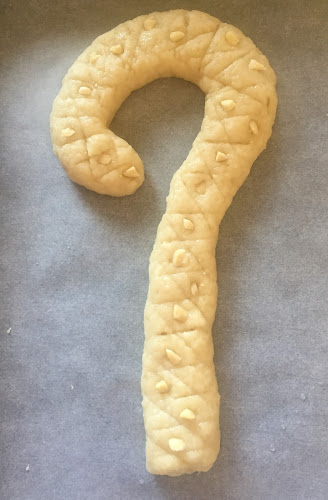
Saint Biagio, bishop and martyr, is often depicted with his bishop’s crosier, the curved tip decorated stick that bishops wear in solemn ceremonies.
As a sign of devotion to the Saint, the women of Serra San Bruno prepare the abbaculu on the day of his feast. It is February 3 and with this cake in their hands they make three laps around the church of the saint before the Holy Mass, just like the number of turns made by the head of Saint Biagio after the beheading.
The abbaculu can only be eaten after the blessing. The lovers will have to share it with the girl following an ancient custom: if she breaks the cake, richly decorated with almonds and sugared almonds, at the height of the volute, keeping the stick for herself and leaving the rest to the lover it means that she accepts the proposal, otherwise it all goes back to the next … abbaculu.
Now let’s go and prepare it.
Ingredients
- 500 grams of flour 00
- 300 grams of sugar
- 250 gr of peeled almonds
- 1 teaspoon of baking soda
- 100 ml of extra virgin olive oil
- 150 ml of hot water
Preparation
In a bowl, pour the flour, sugar and baking soda. Mix the ingredients and then add the oil, water and finally the coarsely chopped almonds.
Knead and when the dough becomes homogeneous, form rolls giving them the shape of a pastoral. According to tradition, the abbaculu should weigh approximately 250 grams, but in our recipe it is preferrable to make them smaller, almost half the weight.
At this point, place them on a pan lined with parchment paper and put them to bake in the preheated oven at 200 ° for about 20/25 minutes. Turn off the oven and leave the abbaculu in for a few hours so that it becomes crunchy.
CALABRIAN CICCITIELLI ALL’ANICE (sweets with anise)
If you look for traditional Calabrian dishes and especially those forgotten dishes that risk disappearing from our heritage, from our memory, this is the case of “Ciccitielli”. It is a dish prepared with simple ingredients that every housewife had at home and that took shape when needed.
The ciccitielli are delicious traditional sweets with the scent of anise. Fried of course, because frying for Calabrians is a must.
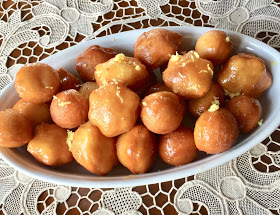
Ingredients
- 500 grams of flour 00
- 150 grams of sugar
- 80 gr of lard
- 100 ml of aniseed liqueur
- 3 eggs
- 2 yolks
- 1 sachet of baking powder
- peanut oil for frying
- sprinkles of sugar
- 200 grams of honey
Preparation
In a large bowl pour the eggs, egg yolks, sugar, lard previously melted, anise and mix. Gradually pour the sifted flour with the baking powder. Work all the ingredients until you get a smooth and compact dough that you will leave to rest in the fridge for a couple of hours. Take the dough and roll it out with a rolling pin into a thin sheet. Cut out many ciccitielli with different molds, fry them in plenty of seed oil and once golden, drain and dry them on absorbent kitchen paper.
Melt the honey in a pan, dip the ciccitielli in it and after having mixed gently pour them into a tray. If you wish, you can decorate the ciccitielli with sugar sprinkles or grate on them the zest of a lemon.
LE PASTETTE (an ancient dessert)
Of the five senses, the sense of smell is the one with the greatest evocative power: the scent of a flower, a sweet, the typical smell of a place can bring back memories that are now dormant in some secret corner of our being. And the pastetta, thanks to its hint of ammonia, tastes of home, of happy childhood, of genuineness, of forgotten traditions.
Pastette were once the symbol of important holidays, such as baptisms, confirmations and weddings. They were prepared by the “maistre” of the town together with biscuits with almonds and baked in a wood oven to be offered to the guests. That coffee bean or almond that often garnished the pastettes was a greedy temptation for me that was difficult to resist and so reaching out to grab them was a matter of a moment.
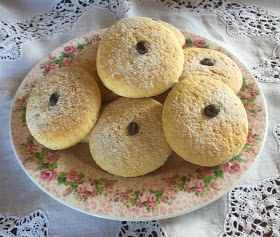
Today everything has changed, no more parties at home, no more sweets prepared with the women of the neighborhood to be served in the “glove boxes”. But the pastettes have not lost their charm, on the contrary they know more of home, of the family because from party sweets they have become breakfast sweets, to be dipped every morning in coffee and milk. A rite I do not give up.
Ingredients
- 500 grams of flour 00
- 200 grams of sugar
- 3 eggs
- 100 gr of lard or 80 ml of extra virgin olive oil
- 100 ml of warm milk
- 20 grams of ammonia
- zest of 1/2 lemon
Preparation
In a bowl, pour the sifted flour, make a fountain and pour in the eggs, extra virgin olive oil, sugar, grated lemon zest and ammonia dissolved in warm milk. Knead everything until you get a very soft, almost sticky dough. Roll out the dough on a floured pastry board, flatten it first with your hands and then with a rolling pin and form the dough with a pastry ring. Brush with milk, sprinkle with sugar and finally place a coffee bean in the center. Bake the pasta in a preheated oven at 180 ° for 15/20 minutes well spaced apart.
FRAGUNI (ancient Calabrian sweets)
The fraguni are typical Calabrian sweets of the Easter period. According to tradition, they are prepared on Holy Thursday to be enjoyed on Easter Sunday to celebrate the Risen Christ. They are sweets with a particular shape stuffed with ricotta, exclusively from sheep, which also included the use of lard and in the salty version the soppressata and pecorino. A simple preparation with 0 km ingredients that were not lacking in the pantry of grand parents.
The name seems to derive from the Latin flado, circular focaccia or from the Greek fagun which indicates the fruit of the beech.
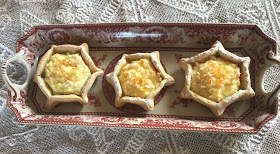
Ingredients
For its pasta:
- 250 grams of flour 00
- 1 egg
- 2 tablespoons of extra virgin olive oil
- 2 tablespoons of sugar
- 1 small teaspoon of baking powder
- lukewarm water q.s. (I about 50 ml)
For the filling:
- 200 gr of sheep ricotta
- 100 grams of sugar
- 1 yolk
- cinnamon to taste
- grated orange zest
- orange liqueur q.s.
Preparation
For the pastry make a dough with the flour sifted with the yeast, egg, sugar, oil and enough water to have a smooth and elastic dough that does not stick to your hands. Let it rest for about an hour covered with a cloth.
Meanwhile, prepare the filling. Put the ricotta in a bowl and mix it with the sugar and the yolk. Add the cinnamon, the orange zest and a little liqueur. The cream must be rather rustic. Let it rest in the fridge. Roll out the dough and with a mold make circles of about 6/7 cm in diameter. Pinch the dough along the circumference with your thumb and forefinger in order to obtain a basket.
In the center pour the ricotta.
Brush the fraguni with milk, place them in a pan lined with parchment paper and bake at 180 degrees for about 20 minutes. Once baked, sprinkle with icing sugar and decorate with candied orange (optional).
SGUTE CALABRESI (Calabrian Easter cake)
Each of us has in his drawer a food that has in itself scents and memories that with a single bite have the ability to take you back in time. And this food for Calabrians is the cuzzupa which, according to the territories in Calabria, takes different names: sgute, ‘ngute, cudduraci, cuculi. But whatever name this dessert has it represents Easter, to be correct Calabrian Easter, before it was supplanted by chocolate eggs and doves.
Different names but also different doughs: they can in fact be leavened or shortcrust biscuits.
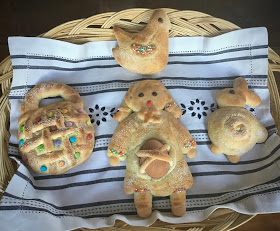
The origin of these sweets is ancient and reminds us of our Greek ancestry. Even the forms recall millennial rites that mix sacred and profane: ‘a palumba (the dove) symbol of peace and the Holy spirit; ‘u panaredhu (the basket) is a pupa (the doll) for us little girls; ‘a cuddura (the intertwined donut) symbol of prosperity.
During the Holy Week the alleys of Calabrian villages were flooded with perfumes coming from the wood-burning ovens that never rested; in the houses children enjoyed decorating their sweets with colored candies while an intense perfume was invested between one batch and the next; all while in the air you could hear the sound of “touches” inviting people to participate in religious services.
Ingredients
- 1 kg of flour 00
- 300 grams of sugar
- 5 medium eggs
- 150 gr of lard or 100 ml of extra virgin olive oil
- 50 ml of milk plus more for brushing
- 20 grams of ammonia
- grated zest of 1 lemon
To decorate: hard-boiled eggs and colored strips of silver paper.
Preparation
Put the flour in a large bowl, pour in the center the lightly beaten eggs, the melted and warm lard, the grated lemon, the sugar and the ammonia dissolved in a little warm milk. Knead and if the dough seems hard, add some milk. Let it rest for half an hour in the fridge. After this time, make the shapes you prefer, but remember that on these Easter cakes you have to set hard-boiled eggs, always in odd numbers though! Then line the trays with parchment paper, place the sgute, brush them with milk or beaten egg and decorate with colored sprinkles.
Bake at 180 degrees for 15/20 minutes until they become golden.
TURDILLI (Calabrian sweets)
Turdilli are sweets similar to gnocchi, naturally fried, typical of the Christmas period and originating in the province of Cosenza. But they’re so good it’s a shame not to make them when you feel like it. Like many other traditional country recipes, there are many variations, eventually without yeast and without eggs. The ingredients to prepare the turdilli are few and simple, they were, and still are, easily available ingredients: flour, extra virgin olive oil, wine and honey. And on this last product I dwell a little because according to tradition fig honey should be used, with its characteristic dark color, which is almost impossible to find and also to do given the long processing and the low yield. It can be used honey from sulla flowers and as a wine a red raisin wine that makes the turdilli more aromatic.
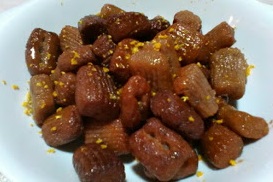
Ingredients
- a glass of extra virgin olive oil
- a glass of granulated sugar
- a glass of red raisin wine
- flour to taste
- Seed oil for frying
- Orange peel
Preparation
In a bowl pour the raisin wine and extra virgin olive oil, then add the sugar and as much flour as the liquids take. Knead until you have a homogeneous and non-sticky mixture.
Divide the dough into pieces, form small cords the size of a finger and cut them into pieces, just like you do for gnocchi.
The dimple that will be created with this operation will then be filled with honey making the turdilli even more succulent. Now fry them in abundant boiling oil until they acquire a nice amber color and once ready drain them on absorbent paper.
Heat the honey in a large pan, then dip the turdilli in and mix to cover them completely. Finally, place them on a tray and decorate with the grated orange zest. If you let them rest they will be even tastier, but it will be difficult: they are one leads to another!
PANICELLI D’UVA (Grape sweets: the Calabrian dumplings of which D’Annunzio was fond)
It is an ancient recipe, whose realization requires a long and patient work which, even today, is carried out thanks to the teaching of the older generations. Grape panicelli, also known by the name of “loaves”, are a confectionery specialty of the towns of the upper Tyrrhenian coast of Cosenza, including: Verbicaro, Diamante, Scalea, Santa Maria del Cedro.
Their composition includes dried raisins (olivella, rugia or zibibbo quality) with large berries and small pieces of cedar peel enclosed in cedar leaves tied with rush or with wild broom thread; obtained the bundle, is baked in the oven.
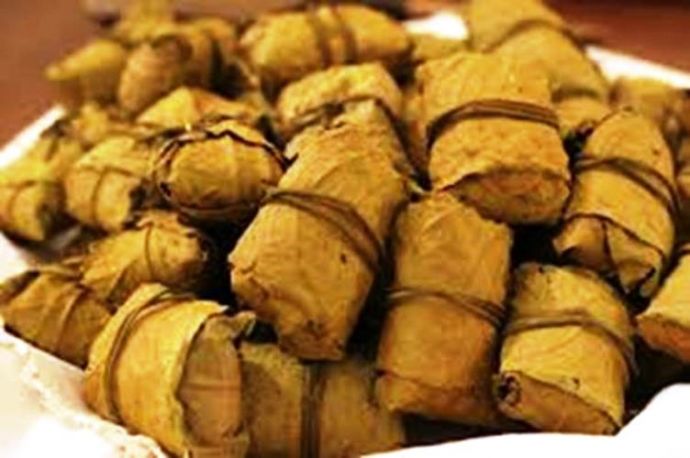
They are to be tasted as a dessert together with a good liqueur or a passito wine. Included in the regional list of Traditional Food Productions.
These bundles had already been appreciated by Gabriele D’annunzio, who wrote by the way: “… I smile thinking of those bundles of compressed leaves and risecche, come from Calabria that one day amazed and enchanted you, when I offered them on a tablecloth lying on the grass not yet mown … The packages were quadrilong in shape like small volumes sealed by a solitary who had happily confused the library and the garden. It took a nail to break the first peel … the last leaf in which the fragrant secret like bergamot is wrapped. The nail breaks it: the fingers open and are tinged with yellow sauce, they are anointed with nothing but solar ointment. A few dried and burnt grapes … a few wet grapes and I would almost say oiled with that unspeakable oil where any chestnut eye rotates that I know myself, a few berries of the sun vine cluster appear pressed against each other, with something of luminous in the brown , with a flavor that delights us before being savored. ..… “(cited from” Leda without swan “)
Preparation
The bunches of grapes just picked undergo the “leaching”, they are practically tied to a stick and immersed for a short time in a solution of water and ash, the latter acts as a disinfectant, (the ash was once used in ancient times both for laundry both for washing and disinfecting dishes), a light layer will form on the berries that will have a double function, disinfectant and protective (the ash will keep insects away).
DESSERTS
MULBERRY GRANITA
Perhaps not everyone knows that, from the Middle Ages to the unification of Italy, silkworm breeding was highly developed in Calabria. The finest silk came from this region; each house had its own loom for weaving this wonderful fiber and the cultivation of the mulberry tree, whose leaves the silkworms are voracious, was widespread throughout the region. With the passage of time, things have changed, the cultivation of mulberry is almost completely forgotten. Fortunately, blackberries can still be found at some local market so that we can allow us to make homemade jams, ice creams and granitas.
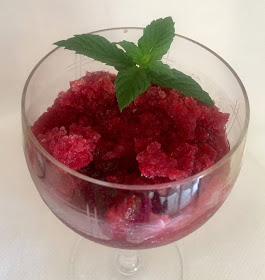
Ingredients
- 300 gr of black blackberries
- 100 grams of sugar
- Juice of ½ lemon
- 200 ml of water
Preparation
In a saucepan, heat the water and sugar over medium heat until the sugar has dissolved well and thus obtain a syrup. Turn off and let cool.
Carefully wash the blackberries, then dry them and pass them through a vegetable mill to obtain the pulp and juice. Squeeze half a lemon and add it to the juice along with the syrup.
Pour everything into a large container and refrigerate. Stir every half hour for 3 or 4 times until the granita has reached the desired consistency.
Your granita is ready to be enjoyed!
“BUON APPETITO!“

